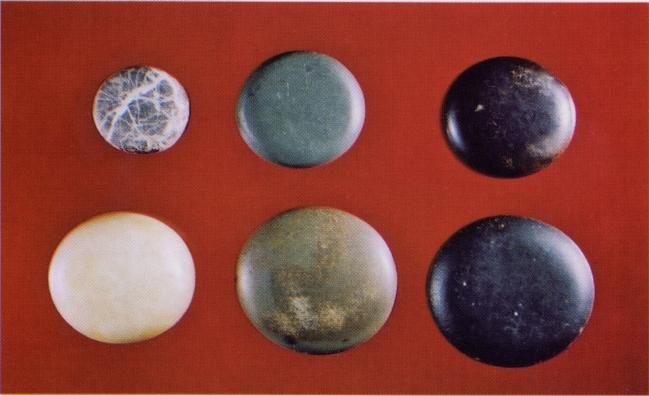by Col. John F. Berner
Central States Archaeological Journal, Vol. 55, No.2, pg.72
The Mississippian culture which began around 900 AD and terminated in the late 1400’s left an indelible mark on the prehistory of the United States. We know that Coles Creek, Etowah,Cahokia, Spiro and the Ohio Valley Ft. Ancients played a significant part. Phases such as Hiawassee, Mouse Creek, Dallas were established during this period.
Just prior to the Mississippian period the use of discoidals began with the Jersey Bluff culture.They manufactured large, heavy granite and quartzite circular discs. French religious explorers witnessed and documented historic tribes playing rolling games and wagering everything they owned on the outcome of these discoidal games.

Figure 1: Marble 1″, Murray Co., GA., Greenstone 1 3/8″, Bradley Co., TN., Hematite 1 1/4″Mississippi Co., AR., Quartzite 1 5/8″, Floyd Co., GA., Greenstone 1 3/4″, Polk Co., TN., Diorite, 1 3/4″, Henry Co., TN.

Figure 2: Diorite, 1 13/16″, Walton Co., FL., White Flint 1 13/16″, Greene Co., TN., Greenstone, 1 3/4″, Bradley Co., TN., Limestone 2″, Floyd Co., GA., Greenstone 1 3/4″, Polk Co., TN., Golden quartzite, 1 7/8″, TN.
Following Jersey Bluff were Cahokia types Apple types from Arkansas and Missouri, rare Salt River types from Missouri and most impressive single and double cup Tennessee types. These were made of the most impressive and colorful stones including a variety of quartzites and especially a golden translucent quartzite. A few were manufactured from reddish / orange ferruginous quartzite.These discoidals range from 4 to 6 inches.
Being native of Southwestern Ohio, I seldom noticed the Mississippian artifacts called “Gamestones”. They appeared to me to be a miniaturization of the larger and earlier gaming artifacts, but what kind of game would engage these smaller counterparts?
Most gamestones are round and flat, occasionally slightly raised on each side and referred as biscuit types. A few are described as “circle roller” types because one side is a larger diameter causing it to roll in a circle as it comes to rest. One rare type of hematite, from Mississippi County, Arkansas was relief carved on one side ( figure 3 ).
Gamestones are made of diorite, green-stone, hematite, quartzite, limestone and flint. The majority are less than three inches in diameter and one and one quarter inches in thickness. The smallest known made of gray and white marble measures just one inch. If they were used like other types of discoidals, what kind and size of gaming field did they employ?

Figure 3: back side of Hematite 1 VI” example from Mississippi Co., AR.
Perforated and engraved sandstone discs similar in size are found at Ft.Ancient sites in the Ohio River valley. Gamestones (like discoidals) have definite wear patterns on the rolling surface. They are not common and found throughout the southeastern states.
If these tiny artifacts were used like their larger counterparts, then they are truly a Mississippian enigma.
“Used by Permission of the Author”
To learn more about or to join the Central States Archaeological Society, click here: http://www.csasi.org/ .